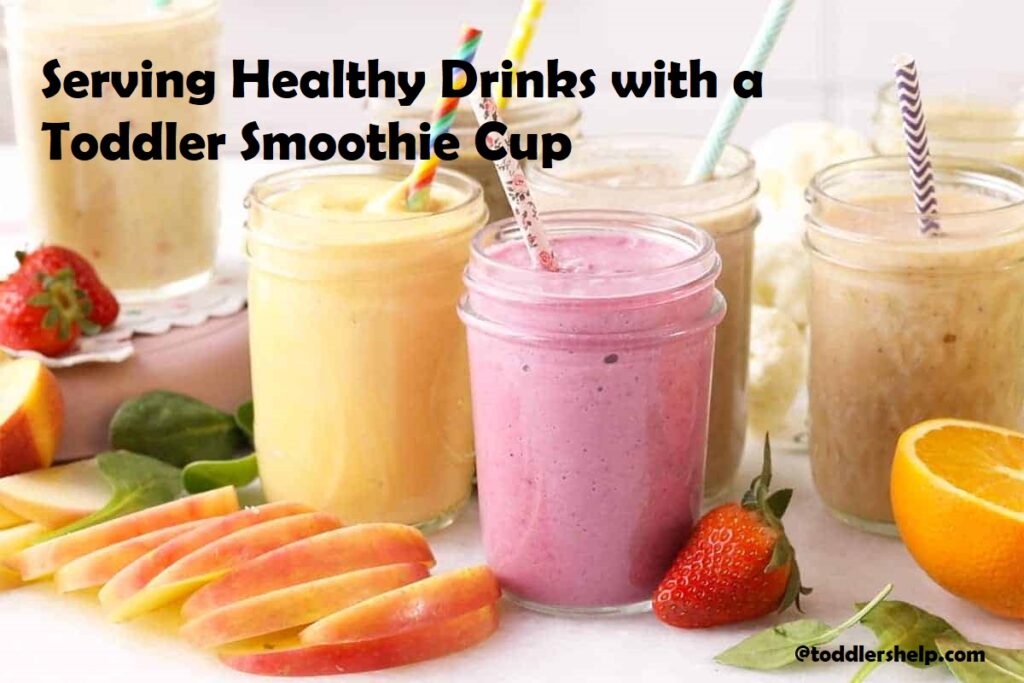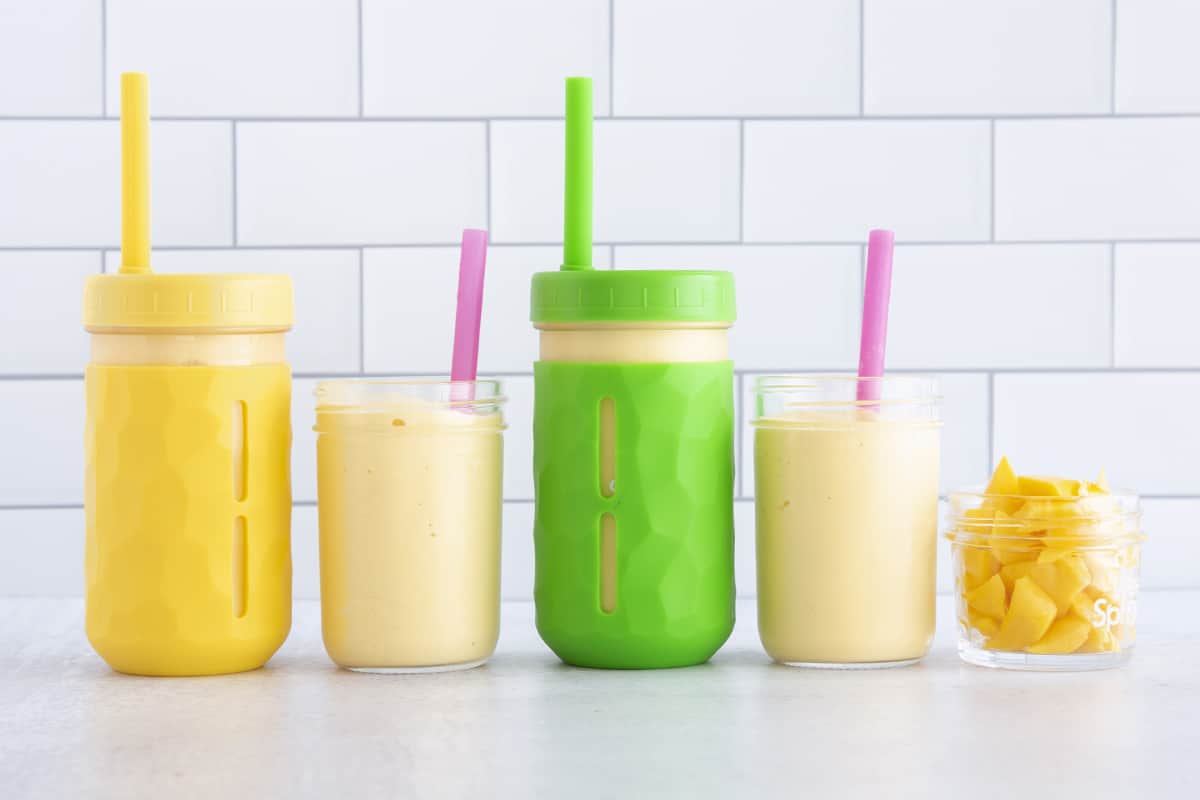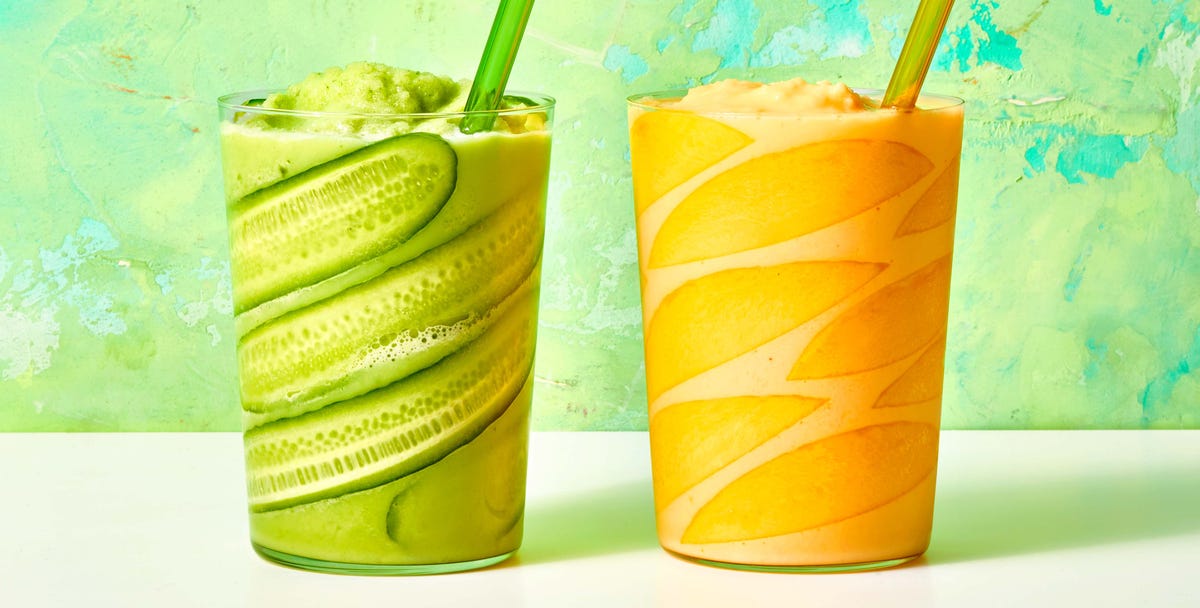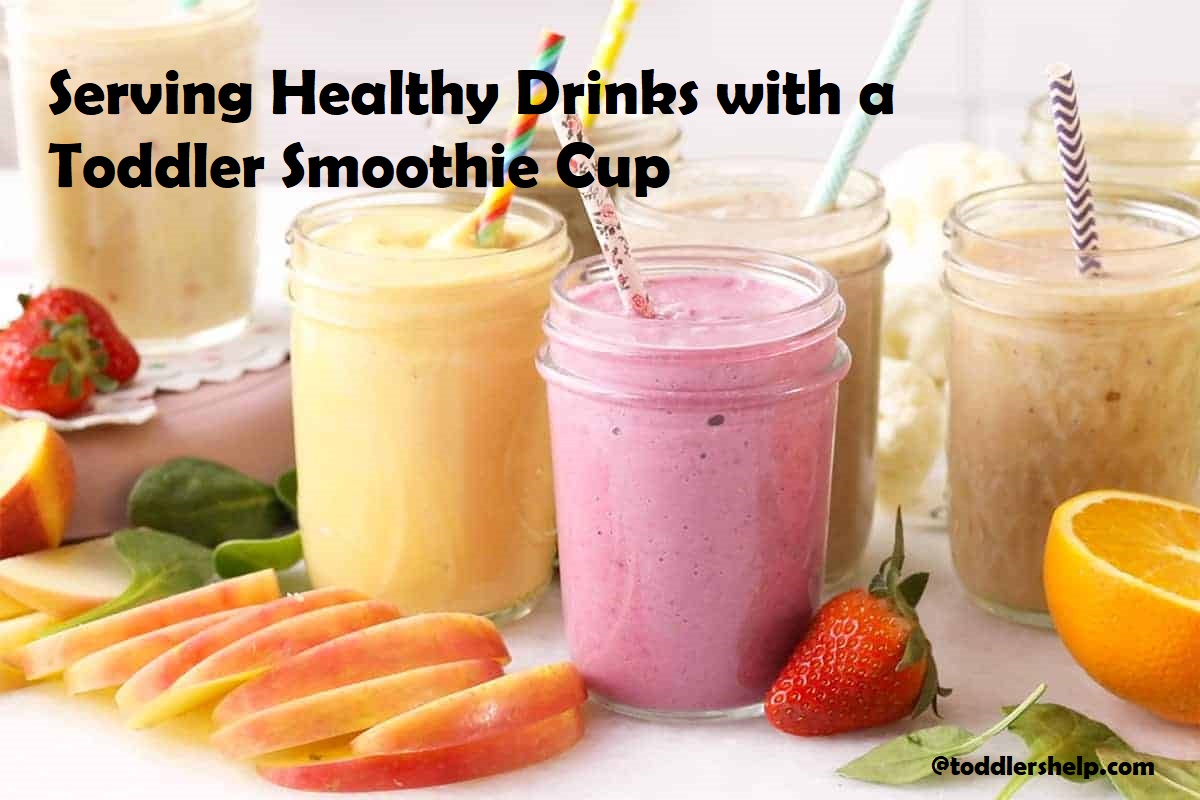Are you worried about the amount of sugar your toddler consumes? Looking for healthy and nourishing drinks that’ll keep them hydrated, without triggering sugar highs? Look no further!
This complete guide will help you serve healthy drinks with a toddler smoothie cup. You don’t have to sacrifice taste for health anymore!
A healthy and nutritious diet is key to a toddler’s development, but getting young kids to eat their vegetables and fruits can be a challenge. Fortunately, serving a smoothie in a Toddler Smoothie Cup makes it easy for children to receive their daily intake of beneficial vitamins and minerals without the hassle of preparing traditional meals. The colorful and fun Toddler Smoothie Cup is an ideal way for parents to ensure that their toddler gets their recommended daily amounts of healthy drinks.
In this guide, you will find information about the benefits of the Toddler Smoothie Cup, instructions for using it correctly and some ideas for putting together great smoothies that your little one will love. With its easy-to-use design, there’s no reason why your toddler shouldn’t enjoy delicious and nutritious drinks while they learn valuable skills like drinking from a cup. Keep reading to get started!
Explanation of the importance of healthy drinks for toddlers
Providing healthy drinks for toddlers is a vital part of promoting their overall health and well-being. Infants and young children require adequate fluid intake to support their growth and development, but toddlers can be picky eaters and may not always choose nutritious beverages. Offering a variety of healthy drinks from a toddler smoothie cup can help parents provide the essential nutrients required for healthy growth, while encouraging healthier beverage choices.
Healthy drinks can help your toddler stay adequately hydrated throughout the day and are an important part of providing all the essential vitamins and minerals needed for proper development in children. For example, milk is rich in calcium, Vitamin D, phosphorus and other essential vitamins which are critical for bone strength; fruit juices are an excellent source of Vitamin C and other antioxidants which help boost immunity; herbal teas provide antioxidant properties as well as calming benefits; water is vital for maintaining hydration; and many enriched milk alternatives offer unique flavors with added vitamins such as A, B12, E6, etc.
In addition to providing nutritional benefits, healthy drinks also help promote good dental health in toddlers by helping protect teeth from decay caused by acids found in some sugary beverages or concentrated fruit juices. Drinking water throughout the day also helps reduce sugar intake which can lead to tooth decay later on when baby teeth start to fall out. With so many advantages of offering healthy drinks to toddlers, it’s no wonder why parents are reaching for special toddler cups designed just for this purpose! By using fun shaped cartoon characters or bright colored designs on a smoothie cup specifically designed for little hands, it will be easier than ever before to encourage your child to choose nutritious beverages over sugary ones every time!
Introduction to the concept of a toddler smoothie cup
Adding healthy and tasty drinks to your toddler’s diet can be challenging. However, one way to create a fun solution is with a toddler smoothie cup. This type of cup is perfect for little fingers as it is designed to fit a small hand perfectly, making it easy for toddlers to drink from. They come in many different colors and designs and can be filled with delicious smoothies, purees, or other healthy drinks that will help your toddler get the nourishment they need.
A smoothie cup is quite versatile in terms of ingredients used. These cups are usually made from non-spill material which makes them perfect for use outdoors or during car trips. Parents can also add flavors and spices that their little ones may enjoy, such as bananas and honey or mushrooms and spinach. With these cups you also don’t have to worry about spilling or messes as the lid snaps on securely.
Not only are smoothie cups great for encouraging healthy eating habits, but they also provide an opportunity to teach toddlers self-sufficiency by allowing them to feed themselves using the cup’s ergonomic design. Learning how to use their hands helps them progress developmentally while having fun at the same time! In addition, drinking out of their own special cups encourages positive self-image since they get to feel like a big kid when it’s their turn at the dinner table!
Overview of what will be covered in the guide
This guide will provide an overview of all the necessary information you need in order to successfully serve healthy drinks using a toddler smoothie cup. In particular, the guide will cover:
– How to select appropriate and healthy ingredients for creating your own smoothies.
– Different methods for making smoothies with toddler cups, including recipes and creative ideas to keep food interesting for picky eaters.
– Tips and tricks on how to best serve smoothies at home and on-the-go.
– Ways to use smoothies as part of meal planning for children who dislike vegetable options.
It is our hope that this guide will be a helpful resource to you as you create delicious and nutritious beverage options with ease!
Choosing the Right Toddler Smoothie Cup
It is important to choose the right toddler smoothie cup for your child. There are many different types of cups available, from selected plastic cups to insulated stainless steel containers. Each type of cup has its own advantages and disadvantages.
When selecting a cup for your toddler, look for one that is made of non-toxic and food-safe materials. It should also be easy to clean and durable enough to withstand daily use without cracking or breaking. Besides the material, size matters as well; choose a cup with a snug lid that fits on securely without leaking and won’t fall off in a busy daycare setting.
Reusable plastic cups are often the least expensive option and come in bright colors, shapes and sizes that may appeal to children. They are lightweight yet sturdy enough for kids’ mouths an easy to fill since they do not require a straw or bottle opener. However, because of their lightweight design it is more likely that these cups will break if dropped by toddlers on hard surfaces like tile or concrete.
Insulated stainless steel containers are more expensive but are highly durable due to their metal construction. They also keep smoothies cold during outdoor activities like picnics or trips in hot weather by maintaining the temperature of your drink inside the container itself. Stainless steel takes longer to heat up than other materials like plastic which can lead hot drinks growing cold quickly after pouring into them for consumption – so take care when selecting stainless steel material for beverages with hot temperatures such as coffee drinks and teas.
Importance of choosing a cup that is safe and easy for toddlers to use
Choosing a cup that is safe and easy for toddlers to use when consuming healthy beverages is an important factor in the overall efficacy of their nutritional intake. It plays a major role in determining how much they can consume in one serving, as well as how comfortable they are with using the cup to drink from. Different cup styles will also cater to different age groups, safety features, design features and ease of cleaning.
For toddlers, straw cups and non-spill toddler cups are popular choices. Straw cups are made to prevent spills with specially designed straw openings in the lid and require more coordination from the user to sip from the straw properly. This can promote better tooth health for young children who tend to gain wisdom teeth earlier than their adult counterparts do. Additionally, these wonders help cut down on germs and bugs that might be lurking around your little one’s drinking container due to its sealable straw feature which prevents spilled liquids from entering it when tipped upside down or dropped.
Another great option is a non-spill toddler cup which has a small spout on top that allows your child to drink without fear of an accidental spill. These cups typically come equipped with two small handles that give your child control over the flow of liquid into their mouth without having them tip the cup too far back in order to drink all the contents within it. Not only are these safer but they also help promote better coordination because they don’t require strength or skillful maneuvering – just tilt and drink! Oftentimes they also come with additional features such as insulated layers that keep cold drinks cold longer or even glow-in-the dark lid covers for convenience during bedtime feedings along with various theme covers so kids have fun picking out their favorite ones!
Features to look for when selecting a toddler smoothie cup
When it comes to selecting a toddler smoothie cup, there are several features you should consider before making a purchase. It is important to think about the design and construction of the cup, as well as any special features that will make it easier and more enjoyable for your child to use.
Design: You want to make sure the cup is designed with young kids in mind and looks attractive enough for your child – it should be colorful and engaging. It’s important that the design is ergonomic – with detailing on the handle or body that makes it easy for your child’s hand grasp, thumb placement, and fingers to balance or hold onto the cup without slipping away too easily.
Construction: Make sure that you select a smoothie cup made from quality materials that won’t harsh odors or flavors into drinks over time. Factors such as BPA-free plastic, phthalate-free plastic, stainless steel, etc., can all impact what kind of material makes up the container itself. Check to see if there are any additional features such as insulation or temperature controls which could be helpful in keeping drinks at a comfortable temperature for your toddler during use.
Spill Resistance: Selecting a smoothie cup with spill resistance features can be beneficial when it comes to providing beverages to an active toddler. Spill resistance allows smoothie beverages when tilted over too far so they won’t come pouring out everywhere unexpectedly; however, these devices should also remain accessible enough so they can still easily drink from them when angled appropriately.
Additional Features: You may also look into extra features such as straws which may stay retracted unless pulled or pushed open by your child’s mouth so messes won’t happen when not in use; some cups feature alternative spouts for particular needs such as staying cool over longer periods of time; others even have vents along the sides granting control over sipping speeds depending on needs; some containers feature lids with handles making them easier for kids to take along on travels – just make sure these options do not interfere with shake time!
III. Making Healthy Toddler Smoothies
Smoothies can be an excellent source of healthy nutrition for toddlers. By combining fruits, vegetables and healthy dairy or dairy alternatives, parents can easily create a nutrient-packed snack in minutes.
When making smoothies for toddlers, use fresh or frozen fruit and vegetables that are soft and ripe. Be sure to follow recommended proportions for ingredients; three parts fruits and vegetables to one part liquid. It is important to consider texture when making smoothie recipes for young children as it can be difficult to drink smoothies with too many icy chunks. Parents should avoid adding honey, as it is not recommended for children under the age of one year old, and should use unsweetened yogurt or non-dairy options if desired.
To make a smoothie with a toddler cup:
- Gather the necessary ingredients which could include: 1 cup of fresh or frozen fruit/vegetables such as berries, avocado, banana or spinach; ½ cup of plain yogurt (cow’s milk-based or plant-based); 1 tablespoon nut butter; ¼ cup liquid such as 100% juice, water or cashew milk (optional).
- Combine ingredients in blender until desired consistency is achieved.
- Add ice cubes if needed to reach desired thickness (optional).
- Serve in a toddler cup and enjoy!
For extra taste and nutrition with every sip add some oats, chia seeds or flax meal – all good sources of fiber that also help thicken drinks without added sugar– almond butter instead of regular peanut butter adds an additional boost of calcium and healthy fats– mix Greek yogurt into smoothies instead of regular yogurt adds protein– use apple cider vinegar helps naturally sweeten drinks without adding sugar– add kale or spinach adds iron -vital mineral needed during toddler development years – infuse shakes with bee pollen supplies essential nutrients including vitamin B complex -and carotenoids
Importance of using healthy ingredients in toddler smoothies
Toddlers require a balanced diet to promote healthy growth and development. One way to get a nutritious, balanced snack is by incorporating smoothies into the daily routine. Preparing a smoothie at home is an excellent option as it allows you to control the ingredients and choose healthier items like fruits and vegetables. Incorporating healthy ingredients into your toddler’s smoothie can also be an opportunity for fun experimentation.
When making a smoothie for your toddler, it is important to remember that toddlers have developing taste buds and texture preferences which may vary from day to day. A toddler’s taste buds may prefer sweet flavors such as fruits while other days they will appreciate different flavors like yogurt or greens. Texture preferences can also vary from creamy, thick or thin consistencies, so you may need to experiment until you find something that your child loves and is willing to consume every day.
When selecting ingredients for a toddler smoothie, fresh fruits offer some of the best nutrition available with high levels of vitamins and minerals, so try adding any kind of fresh fruit such as bananas, apples or berries into their cup. Additionally, adding leafy green vegetables provides natural antioxidants which support immune system health while adding plant-based proteins from chia seeds, hemp hearts or nuts offers sustained energy throughout the day. Last but not least, including yogurt boosts immunity by providing healthy bacteria while increasing calcium content in their diet – all while offering an array of delicious flavors!
Nutritious ingredients to include in toddler smoothies
Including nutritious ingredients in toddler smoothies is an easy way to ensure your little one is getting the vitamins and minerals essential for their growth. When looking for ingredients to include in a smoothie, it is important to opt for whole foods containing natural sugars such as fruit, over processed sugars found in chocolate, candy or other sweets. Here are some nutritious ingredients to consider adding to your toddler’s smoothie:
-Avocado: Avocados are high in healthy fats and packed with vitamins B6, C and E as well as folate and potassium which support a strong immune system. They also help create a creamy texture in the smoothie.
-Banana: Bananas offer important electrolytes such as potassium, magnesium and calcium which help regulate the body’s pH balance. Bananas also provide healthy carbohydrates that give toddlers lasting energy throughout the day.
-Berries: Including berries such as blueberries and raspberries can add extra nutrients, antioxidants, vitamins and fiber to a toddler’s smoothie.
-Spinach/Kale: Leafy greens like spinach or kale make excellent additions to any smoothie recipe because they provide important vitamins like Vitamin A, Iron and calcium essential for optimal health.
* Oats: Oats can add fiber and protein to create heartier texture of the smoothie while making it more filling.
* Yogurt: Yogurt adds calcium, phosphorus and other important minerals that help build strong teeth and bones.
* Flaxseed Meal: Flaxseeds carry both essential fatty acids Omega 3’s ALA (alpha linoleic acid) helps with brain development.
* Honey/Maple Syrup: A tablespoon of honey or maple syrup will naturally sweeten the overall flavor of your toddler’s smoothie without introducing processed sugars or artificial sweeteners.
The key component in creating a nutritious yet satisfying child friendly smoothies is selecting wholesome ingredients packed with nutrients plus adding much needed calories from sources that may not be part of their regular diet during meal times!
Recipes for healthy toddler smoothies
When it comes to healthy eating for toddlers, smoothies can be an ideal way to incorporate a variety of fruits, vegetables and dairy into kids’ diets. A smoothie cup can help make it easier for toddlers to sip their smoothies on their own. This guide provides a variety of recipes for healthy toddler smoothies that can be enjoyed from a toddler-safe cup.
Toddlers will love the delicious taste of these nutrient-rich drinks that also include added vitamins and minerals from nut butters and yogurt. Smoothie recipes like banana-berry and mango-orange offer classic flavor combinations that are sure to please even the pickiest eaters. For something more adventurous, there are recipes such as green spinach or pumpkin puree that feature unexpected ingredients and fun colors.
Smoothie cups make it easy for parents to provide nutritious snacks or snacks when on the go in an age-appropriate container that’s designed specifically with toddlers in mind. With a range of recipes using an array of wholesome ingredients, your toddler is sure to find something they love in this guide on how to make healthy toddler smoothies!
Tips for Serving Smoothies to Toddlers
Making smoothies for toddlers is a great way to give them healthy nourishment. Since toddlers are picky with their food choices, incorporating fresh fruits and vegetables can be quite challenging. Smoothie cups can help give them the nutrition they need while exploring different flavors and textures.
Here’s what you should keep in mind when serving smoothies to your toddler:
-Keep it simple: Try to avoid adding too many ingredients for your toddler’s smoothie. You don’t want to make it too complicated for them or overwhelm them with textures, flavors, and colors inside their cup. Sticking to two or three ingredients is best.
-Choose nutritious ingredients: To ensure that your child is getting adequate vitamins and minerals in their drink, choose nutrient-dense ingredients like leafy greens, fresh berries, oranges, mangoes, nuts and nut butters, Greek yogurt, and aloe vera juice. This way they get the best benefits from the smoothie.
-Make sure it’s easy for them to drink: Using a straw or sippy cup can help make drinking easier for young kids who have not quite mastered drinking from a glass yet. Make sure the straw or cup is leakproof so that there are no spills.
-Add ice if necessary: If you’ve made a thicker smoothie consistency or you find your toddler struggling to drink from a straw then adding some ice cubes might help thin it down slightly making it easier for your baby to drink smoothly.
Advice on how to encourage toddlers to drink smoothies
It can be difficult to get toddlers to drink smoothies, but there are a few tips that can help make it easier. If you want to encourage your toddler to drink smoothies, the first thing you should do is choose a fun cup! Kids are often drawn to fun or colorful cups and it might just be enough to get them excited about drinking smoothies. Choose a cup with their favorite character or pick one with bright colors that will capture their attention.
When adding ingredients for your toddler’s smoothie, consider using natural sweeteners instead of sugar or processed sweeteners. Natural sweeteners such as honey, maple syrup, and even dates can provide flavor without the negative health implications. Additionally, adding fruit such as bananas, mangoes and berries will increase the flavor of the smoothie without relying on added sugar for sweetness.
It’s important that your toddler drinks enough throughout the day in order for them to stay hydrated and healthy. Create a schedule if needed; each morning offer them some water from their special cup before having breakfast and later in the day you could offer them a smoothie when they start getting thirsty again. You can also try increasing their liquid intake with other healthy options like herbal teas (no caffeine!), vegetable juices or even lactose free milks if they don’t prefer water or other liquids.
Finally, use positive reinforcement when offering up smoothies – praise your toddler when they gladly drink whatever you have prepared! They’ll learn quickly that drinking healthy beverages is not only enjoyable but beneficial as well!
Conclusion
In conclusion, toddler smoothie cups are a great way to encourage your little one to enjoy healthy drinks while they learn how to be independent at the same time. With so many choices on the market, there is sure to be something that suits the needs of any parent or toddler.
To ensure safe use, always follow the manufacturer’s instructions for assembly and maintenance of your child’s smoothie cup. And remember that water or other plain liquids should form the majority of their fluids until 18 months as juiced fruits and added sweeteners should be avoided until then.
By using this guide and paying careful attention to your toddler’s beverage needs, you can ensure a healthy attitude towards drinking from an early age.
FAQ’S
How do you serve smoothies to a toddler?
Smoothies can be served to a toddler in a sippy cup or a small cup with a straw, depending on their age and preference.
Are smoothies OK for toddlers?
Smoothies can be OK for toddlers, as long as they are made with age-appropriate ingredients and in moderation.
Can 2 year olds drink smoothies?
Yes, 2-year-olds can drink smoothies, as long as the ingredients are suitable for their age and dietary needs.
What is the healthiest liquid to put in a smoothie?
The healthiest liquid to put in a smoothie can be water, coconut water, nut milk, or low-fat dairy milk, depending on the dietary needs and taste preference.
How should smoothies be served?
Smoothies can be served in a glass or a portable container, with a straw or a spoon, and garnished with fresh fruits or nuts for added nutrition and texture.
Can babies have smoothies everyday?
Babies can have smoothies as a part of a balanced and varied diet, but it’s important to consult with a pediatrician and ensure that the ingredients are safe and appropriate for their age and development.
Is a smoothie a breakfast or snack?
A smoothie can be served as a breakfast or a snack, depending on the ingredients and portion size.
Can toddlers have smoothies with protein?
Yes, toddlers can have smoothies with protein, such as nut butter, Greek yogurt, or protein powder, as long as the amount and type of protein are suitable for their age and dietary needs.
Are smoothies better with milk or yogurt?
Smoothies can be made with either milk or yogurt, depending on the desired texture, taste, and nutritional value. Milk can provide a creamy texture and calcium, while yogurt can add thickness, tanginess, and probiotics.
Do smoothies need milk or water?
Smoothies don’t necessarily need milk or water, as they can also be made with juice, coconut water, or even green tea, depending on the desired taste and nutritional value.
See Also-
- Best toddler slippers
- Best toddler toilet seat
- Best toddler golf set
- Best toddler guitar
- Best toddler headphones for plane

